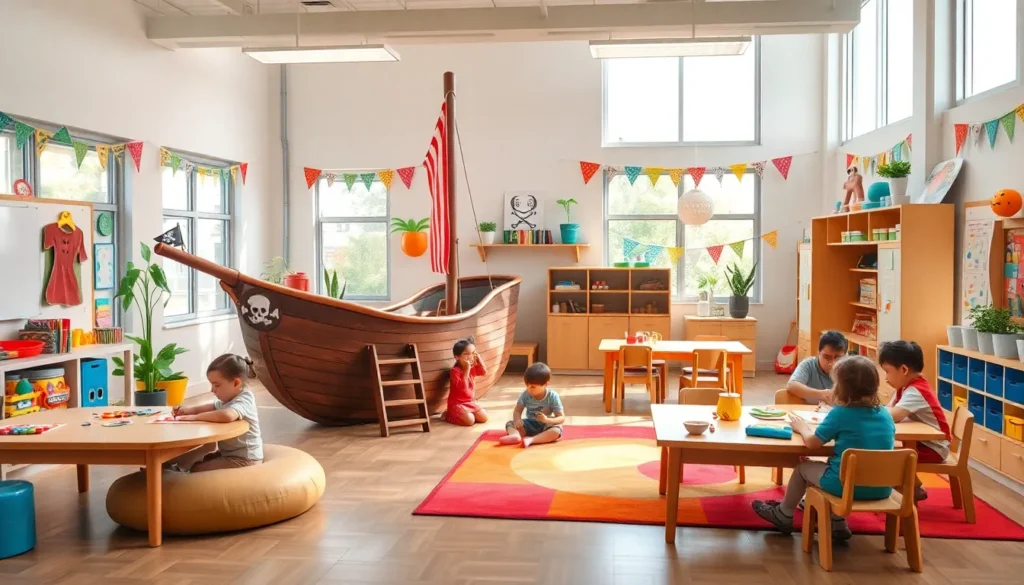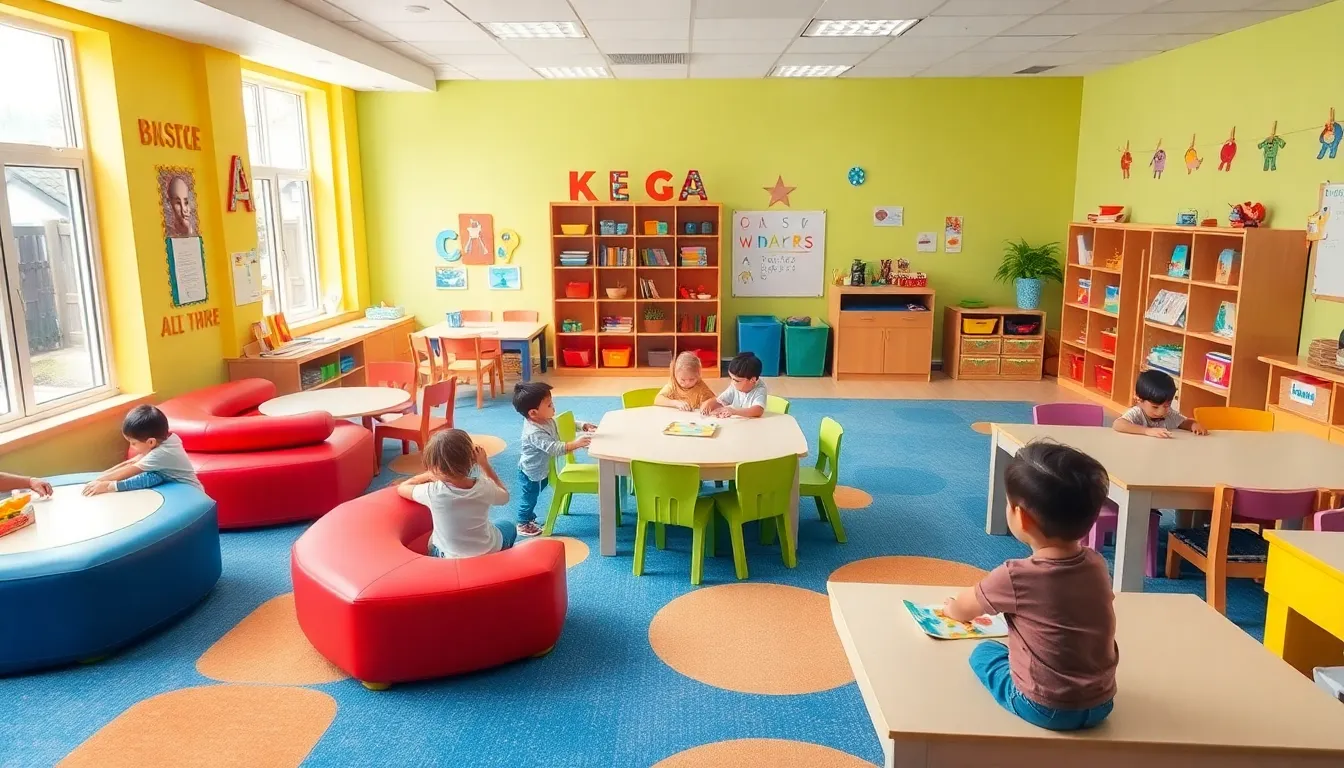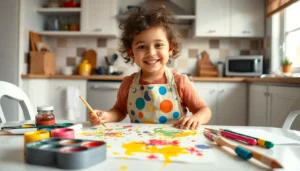Table of Contents
ToggleImagine walking into a preschool classroom that feels more like a wonderland than a learning space. Bright colors, cozy corners, and interactive zones invite little explorers to unleash their creativity. Designing a preschool classroom isn’t just about aesthetics; it’s about creating an environment that sparks curiosity and encourages play.
Every nook and cranny should whisper, “Come learn with me!” From the reading corner that doubles as a pirate ship to the art station that resembles a mini Jackson Pollock studio, the right design can transform learning into an adventure. It’s not just about crayons and building blocks; it’s about crafting a space where imagination runs wild and learning feels like play. So let’s dive into the art of preschool classroom design and discover how to turn the ordinary into the extraordinary.
Importance of Preschool Classroom Design
Thoughtful classroom design enhances children’s learning experiences. Bright colors stimulate interest and creativity, allowing students to engage more fully. Interactive zones encourage discovery and exploration, making education feel enjoyable. Themed areas, like reading corners resembling pirate ships, captivate young imaginations. Art stations should prioritize free expression, fostering creativity without constraints.
Spaces should accommodate different learning styles. Quiet areas support students who need to focus alone, while collaborative zones promote teamwork. Flexibility in design allows teachers to adapt to various activities and group sizes. Safety remains a key factor; furniture and materials must be child-friendly and durable.
Furniture arrangement significantly affects classroom dynamics. Tables in clusters facilitate group work, whereas individual desks can cater to focused tasks. Additionally, easy access to resources encourages independence, boosting self-confidence in young learners.
Natural light and good airflow contribute to a healthy environment. Access to nature, through windows or outdoor spaces, can positively impact mood and learning retention. Incorporating sensory elements like textures, sounds, and scents enriches the overall experience.
Ultimately, a well-designed preschool classroom lays the foundation for lifelong learning. It shapes children’s social skills, creativity, and cognitive development. Prioritizing careful design transforms ordinary settings into vibrant hubs of imagination and knowledge.
Key Elements of Effective Design
Effective preschool classroom design incorporates elements that foster learning and creativity. A thoughtfully arranged space supports children’s development and engagement.
Layout and Space Utilization
Creating designated zones maximizes learning opportunities. Open areas encourage movement while quiet corners provide focus. Strategic placement of learning stations fosters independence and exploration. Group work benefits from tables arranged to promote interaction. Defined areas help children understand boundaries and expectations within the classroom. Accessibility remains crucial, ensuring every corner invites exploration.
Furniture and Materials
Selecting age-appropriate furniture matters for safety and comfort. Soft seating options enhance relaxation during reading times. Sturdy tables support various activities with ease. Materials should be non-toxic and durable, standing up to daily use. Versatile furniture allows easy reconfiguration to adapt to different activities. Textured materials add sensory experiences, enriching the environment for young learners.
Color and Aesthetics
Using bright, inviting colors stimulates curiosity and creativity. Colorful accents can define learning areas and create visual interest. Natural tones provide a calming backdrop, balancing high-energy spaces. Thoughtful wall decorations enhance the learning experience by showcasing children’s work. Various textures and patterns create a dynamic atmosphere that promotes exploration and engagement.
Impact on Learning and Development
Preschool classroom design significantly impacts learning and development. Thoughtfully crafted environments enhance overall educational experiences.
Psychological Benefits
Bright colors and varied textures contribute to positive psychological effects. Engaging learning spaces encourage curiosity and creativity. Children experience reduced anxiety when comfortable and familiar places surround them. Increased opportunities for sensory exploration lead to improved emotional regulation. Spaces designed with safety in mind support children’s mental well-being. Research indicates that natural light can enhance mood, promoting productivity and better focus. Incorporating elements of nature invites relaxation, allowing for a calming atmosphere that aids cognitive processing.
Social Interaction
Effective classroom design fosters social skills and interaction. Designated areas for group activities promote collaboration among peers. Children learn to share and communicate in space that encourages teamwork. Open layouts facilitate movement, supporting spontaneous interactions. The arrangement of furniture allows easy access for collaboration while encouraging learning through play. Spaces with cozy corners invite conversations, helping to build friendships. Design also influences turn-taking skills, teaching patience and cooperation. Ultimately, nurturing social engagement through design establishes a foundation for lasting relationships and community awareness.
Best Practices for Implementation
Creating a preschool classroom that thrives requires strategic implementation of best practices. Flexibility and adaptability in design enhance the learning experience for young children.
Flexibility and Adaptability
Furniture choices should feature versatile designs. Modular tables and chairs allow quick reconfiguration for different activities. Moving elements around supports various group sizes and individual needs easily. Sufficient open space encourages spontaneous play and exploration. This zoning requires careful planning to ensure the classroom remains functional and engaging. Teachers can modify layouts to align with evolving educational goals, promoting a dynamic learning atmosphere. With adaptable settings, children learn to navigate their environment, fostering independence and confidence.
Incorporating Technology
Integrating technology within preschool classrooms enhances learning experiences effectively. Interactive whiteboards and tablets provide engaging educational opportunities. These tools can support diverse learning styles while maintaining student interest. Ensuring that technology is age-appropriate remains crucial for maximizing benefits. Teachers should direct guided exploration of digital resources, helping children develop early tech skills. Regular training ensures educators use technology effectively, fostering collaboration among peers. Incorporating technology also aids in bridging the gap between traditional and modern learning methods, ensuring classrooms remain relevant.
Case Studies and Examples
Several preschool classrooms demonstrate effective design principles in action. The Nature Preschool in Boulder, Colorado, incorporates outdoor learning spaces, allowing children to explore and connect with nature. Children engage in hands-on activities, such as gardening and hiking, which enhance their understanding of the environment.
Another example is the Bright Horizons Learning Center in San Francisco. This classroom utilizes bright color schemes and interactive play areas, promoting creativity and collaboration among students. Designated zones, like a reading nook and an art station, provide opportunities for independent and group learning.
A notable mention is the Stepping Stones Preschool in Austin, Texas. Here, multifunctional furniture adapts to various learning preferences. Teachers rearrange tables and chairs easily to create collaborative spaces or one-on-one focus areas. Natural light floods the room, improving mood and focus while supporting children’s mental well-being.
The Reggio Emilia-inspired classroom at Little Green School in New York City showcases the importance of aesthetic elements. Recycled materials used for art projects encourage creativity while instilling environmental awareness. Textured wall coverings and plants create a dynamic atmosphere, inviting exploration.
In the Preschool of the Arts in Seattle, an emphasis on sensory experiences enriches learning. Spinning wheels filled with colors and soft tactile panels engage young minds in different ways. Quiet corners featuring soft seating provide a retreat for those needing individual focus.
Through these examples, it’s evident that successful preschool classroom designs cater to diverse learning styles and encourage exploration. Effective use of space and materials fosters creativity, collaboration, and emotional well-being, promoting an environment where children thrive.
Conclusion
Thoughtful preschool classroom design plays a vital role in shaping young learners’ experiences. By creating spaces that inspire curiosity and creativity, educators can foster a love for learning that lasts a lifetime. Incorporating diverse learning zones and age-appropriate furniture enhances comfort and engagement, allowing children to explore and interact meaningfully.
The integration of natural elements and sensory experiences not only supports cognitive development but also promotes emotional well-being. As classrooms evolve, flexibility and adaptability in design will remain essential for meeting the unique needs of every child. Ultimately, investing in effective classroom design is an investment in the future of education, ensuring that every child has the opportunity to thrive in a nurturing and stimulating environment.








